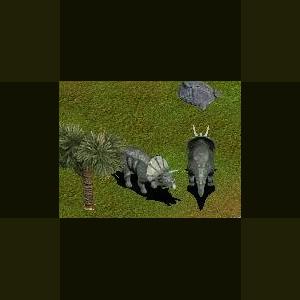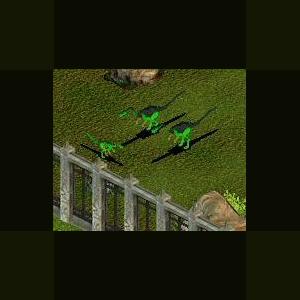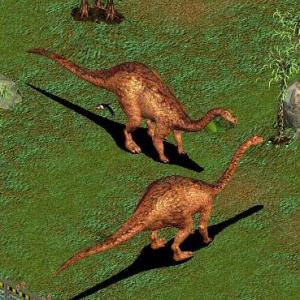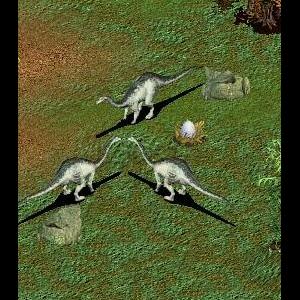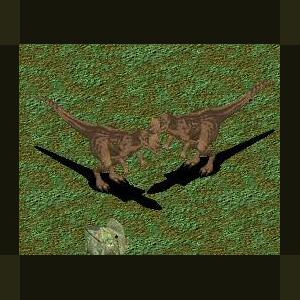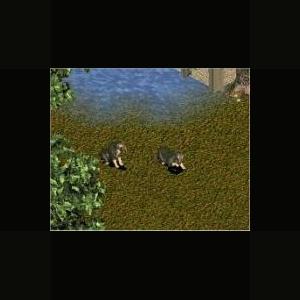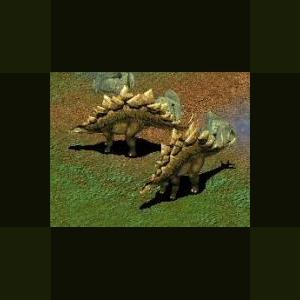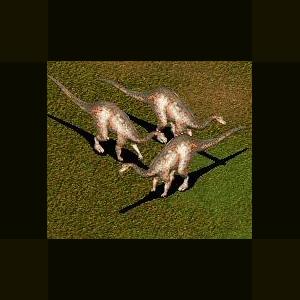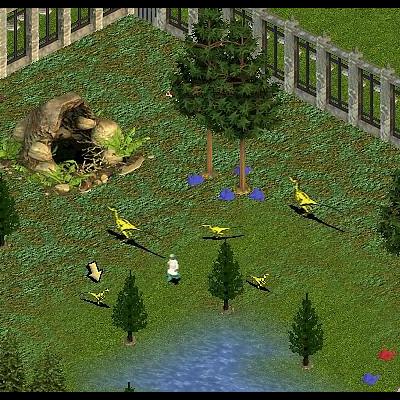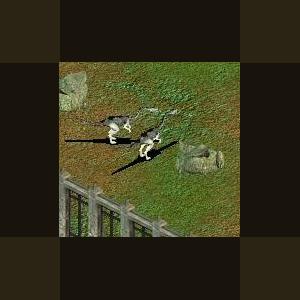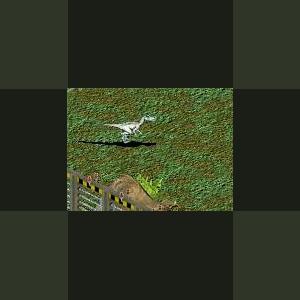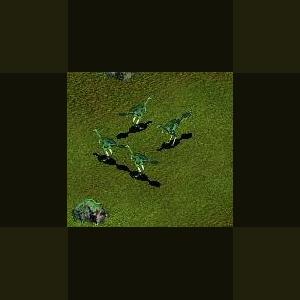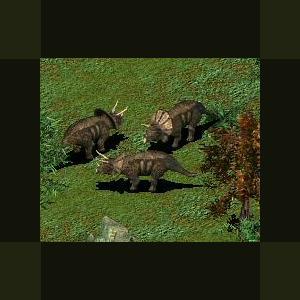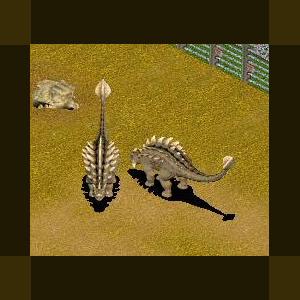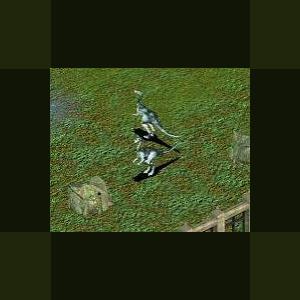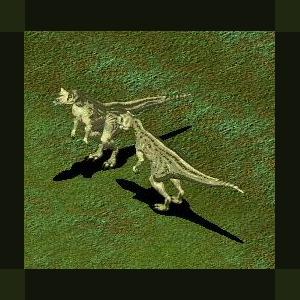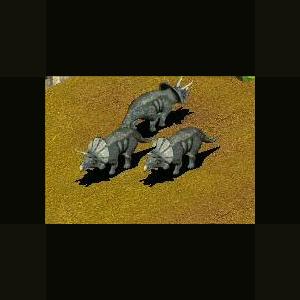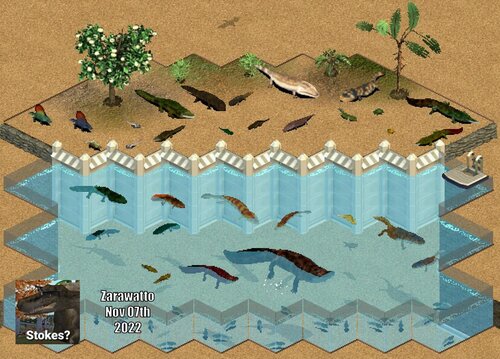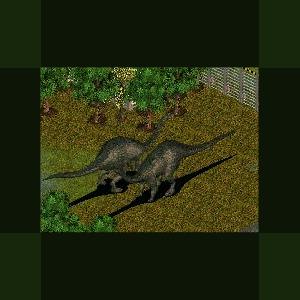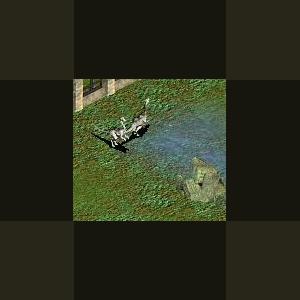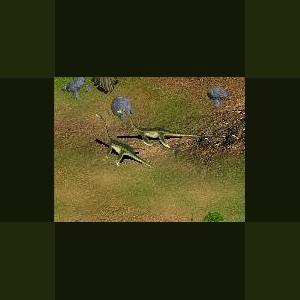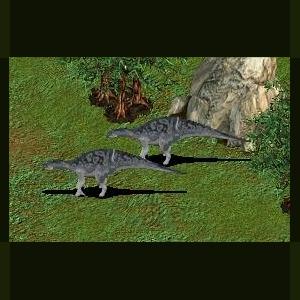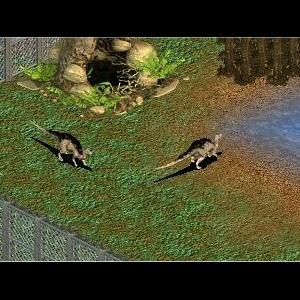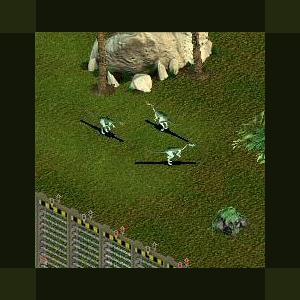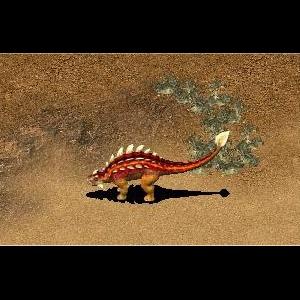Dinosaurs
Creatures from another age
241 files
-
Zuniceratops by Moondawg
By Guest
Zuniceratops
Zuniceratops ('Zuni-horned face') was a Ceratopsian dinosaur from the mid Turonian of the Late Cretaceous Period of what is now New Mexico, United States. It lived about 10 million years earlier than the more familiar horned Ceratopsidae and provides an important window on their ancestry.
Zuniceratops appears to have been roughly 10-11 feet (three to 3.5 meters) long and three feet (one meter) tall at the hips. It probably weighed 200 to 250 pounds (100 to 150 kilograms). The frill behind its head was fenestrated but lacking epoccipitals. It is the earliest-known ceratopsian to have eyebrow horns and the oldest-known ceratopsian from North America. This set of horns is thought to have grown much larger with age.
Zuniceratops was discovered in 1996, by 8 year old Christopher James Wolfe, son of paleontologist Douglas G. Wolfe, in the Moreno Hill Formation in west-central New Mexico. One skull and the bones from several individuals have been found. More recently, one bone, believed to be a squamosal, has since been found to be an ischium of a Nothronychus.
Zuniceratops is an example of the evolutionary transition between early ceratopsians and the later, larger ceratopsids that had very large horns and frills. This supports the theory that the lineage of ceratopsian dinosaurs may have been North American in origin.
Although the first specimen discovered had single-rooted teeth (unusual for ceratopsians), later fossils had double-rooted teeth. This is evidence that the teeth became double-rooted with age. Zuniceratops was a herbivore like other ceratopsians and was probably a herd animal as well.
Zuniceratops is featured in the Discovery Channel Special, When Dinosaurs Roamed America.
http://en.wikipedia.org/wiki/Zuniceratops
268 downloads
0 comments
Updated
-
Zephyrosaurus by Moondawg
By Guest
Zephyrosaurus (meaning "westward wind lizard") was a genus of hypsilophodont ornithopod dinosaur.
It is based on a partial skull and postcranial fragments discovered in the Aptian-Albian-age Lower Cretaceous Cloverly Formation of Carbon County, Montana. New remains are under description, and tracks from Maryland and Virginia have been attributed to something like it.
Zephyrosaurus is still very incompletely known. Among other distinctive characteristics, it had a steep face, a raised knob on the upper jaw, and a larger knob on the cheekbone. Some of the bones may have allowed movement within the skull (cranial kinesis) as well. Like other hypsilophodonts, it had beak teeth.
Hans-Dieter Sues named his new genus in recognition of the fossil being found in western North America, and C. R. Schaff, who found the specimen. MCZ 4392, the type specimen, is composed of jaw fragments, the braincase and associated bones, several partial vertebrae, and rib fragments. He found the new genus to represent a previously unknown lineage of hypsilophodont, similar in some respects to Hypsilophodon.
Because of the fragmentary nature of the type, and lack of additional remains, Zephyrosaurus had not attracted much attention until recently, when two separate events brought it more recognition. First, Martha Kutter, in a 2003 abstract, reported on new remains of this genus under study at the Sam Noble Oklahoma Museum of Natural History, including the remains of at least seven individuals with bones from all regions of the body.
Then, Stanford et al. (2004) published on dinosaur tracks from the Patuxent Formation of Maryland and Virginia, which they named Hypsiloichnus marylandicus and attributed to an animal akin to Zephyrosaurus based on the proportions of the hands and feet.
195 downloads
0 comments
Updated
-
Yunnanosaurus by Moondawg
By Guest
Yunnanosaurus
Yunnanosaurus is a genus of prosauropod dinosaur from the Early to Middle Jurassic Period; a position in time that makes it one of the last prosauropods. It is closely related to Lufengosaurus. Known from two valid species, Yunnanosaurus ranged in size from 7 meters (23 feet) long and 2 m (7 ft) high to 13 m (42 ft) long in the largest species. It is known from over twenty skeletons, including two skulls, recovered from the Lufeng Formation of Yunnan, China.
Yang Zhongjian (aka C. C. Young) discovered the first Yunnanosaurus skeletons in the Lufeng Formation of Yunnan, China. The fossil find was composed over twenty incomplete skeletons, including two skulls, and were excavated by Tsun Yi Wang.
There were more than sixty spoon shaped teeth in the jaws of Yunnanosaurus, and were unique among prosauropods in that its teeth were self-sharpening because they "(wore) against each other as the animal fed." Scientists consider these teeth to be advanced compared to other prosauropods, as they share features with the sauropods.
However, scientists do not consider Yunnanosaurus to be especially close to the sauropods in phylogeny because the remaining portions of the animals body are distinctly prosauropod in design. This critical difference implies that the similarity in dentition between Yunnanosaurus and sauropods might be an example of convergent evolution.
type species, Y. huangi, was named by C. C. Young in 1942, and he erected the family Yunnanosauridae to contain it, though the family currently comprises only this genus. Young also named a second species, Y. robustus, in 1951, but this has since been included in the type species. The confusion in classification arose due to that the earliest specimens were of juveniles while the "Y. robustus" specimens represented fully grown adults.
In 2007, Lu and colleagues described another species of Yunnanosaurus, Y. youngi (named in honor of C. C. Young). In addition to various skeletal differences, at 13 meters (42 ft) long Y. youngi was significantly larger than Y. huangi (which reached only 7 meters (23 ft), and Y. youngi is found later in the fossil record, hailing from the Middle Jurassic.
178 downloads
0 comments
Updated
-
Yimenosaurus by Moondawg
By Guest
Yimenosaurus
Yimenosaurus is a genus of prosauropod dinosaur from the Early Jurassic. Fossils from several individuals were recovered from Yimen, China, and the type species Y. youngi was named by Bai, Yang & Wang in 1990. Reconstructions are based on mostly complete skeletons, missing only parts of the limbs.
146 downloads
0 comments
Updated
-
Yangchuanosaurus by Moondawg
By Guest
Yangchuanosaurus was a theropod dinosaur that lived in China during the Late Jurassic period, and was similar in size and appearance to its North American contemporary, Allosaurus.
It hails from the Upper Shaximiao Formation and was the largest predator in a landscape which included the sauropods Mamenchisaurus and Omeisaurus as well as the Stegosaurs Chialingosaurus, Tuojiangosaurus and Chungkingosaurus
In 1976, an almost complete skeleton of what was to be named Yangchuanosaurus shangyouensis was uncovered by a construction worker during the construction of the Shangyou Reservoir Dam in Yangshuan County in Sichuan Province. Since then further skeletons have been recovered.
Yangchuanosaurus shangyouensis reached about 7 metres long (23 ft) and had a skull around 80 cm long (32 in). Its relative Y. magnus grew larger still; up to 10 metres long (33 ft), with a skull up to 1 metre (3 ft) in length. There was a bony knob on its nose and multiple hornlets and ridges, similar to Ceratosaurus. It had a massive tail that was about half its length.
The original skeleton of Yangchuanosaurus shangyouensis is on display at the Municipal Museum of Chongqing, as is some material of Y. magnus. Another, recovered from Xuanhan County in Sichuan, is on display in the Beijing Museum of Natural History.
181 downloads
0 comments
Updated
-
Xenosmilus by Ghirin
By Guest
Xenosmilus by Ghirin
Xenosmilus ("Strange knife") is a relatively newly described genus of saber-toothed cat.
This genus has one species, X. hodsonae, and the fossils were found in a limestone quarry in Florida.
Xenosmilus lived about 1 million years ago. It was a heavily built feline approximately the size of a lion. The upper canine teeth were relatively short and broad.
References:
www.wikipedia.org
http://www.messybeast.com/cat-prehistory.htm
http://www.niu.edu/pubaffairs/NT/1999/march22/saber.html
266 downloads
0 comments
Updated
-
Wuerhosaurus by Moondawg
By Guest
Wuerhosaurus was a Chinese stegosaur from Early Cretaceous period. It was roughly 7 metres long.
Wuerhosaurus homheni is the type species, described by Dong Zhiming in 1973 from the Tugulu Group in Xinjiang, western China. A smaller species from the Ejinhoro Formation in the Ordos Basin in Inner Mongolia, W. ordosensis, was formalized by the same researcher in 1993.
It was lower to the ground than most other stegosaurids; scientists believe that this was an adaptation to let it feed on low-growing vegetation. Unlike Stegosaurus, Wuerhosaurus had shorter, rounded plates, whose purpose is debated. Wuerhosaurus, like other stegosaurids, had a thagomizer on the end of its tail, which featured four bony spikes that would most likely have been used for self-defense.
Inspired by the Zoo Tek Brains Trust
218 downloads
0 comments
Updated
-
Vulcanodon by Moondawg
By Guest
Vulcanodon (meaning "volcano tooth") was a relatively small, early sauropod dinosaur genus from the Early Jurassic.
It was about 6.5 meters (20 feet) long. Vulcanodon ate plants and lived in southern Africa. The type species, V. karibaensis, was formally described by Michael A. Raath of the University of the Witwatersrand, Johannesburg, in 1972.
It was originally believed to be a prosauropod because of the knife shaped teeth found near its fossils, which fit in with the idea that prosauropods were omnivorous, but scientists now know that the teeth belonged to an unidentified theropod that scavenged on the Vulcanodon's carcass.
152 downloads
0 comments
Updated
-
Variraptor by JohnT
By Admin Uploader
As a cousin of the Velociraptor, your zoo guests will enjoy this colorful but deadly animal.
You must have either DD or CC to use this dinosaur.
87 downloads
0 comments
Updated
-
Valdosaurus by Moondawg
By Guest
Valdosaurus ("Weald Lizard") was a small, bipedal herbivorous ornithopod dinosaur found on the Isle of Wight, elsewhere in Europe, and Africa.
It lived during the Early Cretaceous.
The type species, V. canaliculatus, was described in 1975 by Peter Galton. A second species, V. nigeriensis is known from Niger, but is based on partial fossils. Valdosaurus is an iguanodont.
117 downloads
0 comments
Updated
-
Utahraptor by Moondawg
By Guest
Utahraptor (meaning "Utah's predator") is the largest known member of the theropod dinosaur family
Dromaeosauridae, and dates from the upper Barremian stage of the Early Cretaceous period (132-119 million years ago).
Like other dromaeosaurids, Utahraptor had a huge curved claw on the second toe that could grow to 23 centimetres (9.1 in) long. The animal may have grasped its prey with its forelimbs while kicking with its hindlimbs. Recent tests on reconstructions of the smaller Velociraptor suggest that claws of this type were used for stabbing or suffocating its prey, not slashing into their hide.Up to 6.5 m (21 ft) long, 2 m (6.6 ft) tall, and 700 kg (1,500 lb) in weight, Utahraptor would have been a formidable predator.
Updated by Cricket on April 5, 2012:
Removed space from name
Removed extra verbiage
348 downloads
Updated
-
Unenlagia by Moondawg
By Guest
Unenlagia
Unenlagia (meaning "half-bird" in Latinized Mapuche) was a genus of theropod dinosaur of the family Dromaeosauridae. Unenlagia, which lived in South America during the Late Cretaceous, was a member of the strange and extremely bird-like Gondwanan sub-family of dromaeosaurs called unenlagiines, and was closely related to dinosaurs such as Buitreraptor and Neuquenraptor (which might be the same species as Unenlagia). Makovicky et al. suggested that the 'flying raptor' Rahonavis is also a member of this group, which would mean that either Unenlagia is secondarily flightless, having evolved from flying, Rahonavis-like ancestors, or that bird-like flight evolved at least twice. Norell et al. in 2006 also found Rahonavis to be the sister taxon of Unenlagia.
Unenlagia was very birdlike itself. Novas and Puerta found its pelvic region to be very similar to that of the early bird Archaeopteryx. The shoulder girdle of Unenlagia also shows adaptations for flapping. At 2 meters (6.6 ft long), Unenlagia was probably too big to fly; thus either it evolved from flying ancestors, or Rahonavis (if an unenlagiine) evolved flight from adequately adapted (but too large; see also exaptation) dromaeosaurs independently of the Archaeopteryx lineage, at a time when other bird lineages were already undergoing vigorous adaptive radiation.
The genus Unenlagia has been assigned two species: U. comahuensis, the type species described by Novas and Puerta in 1997, and U. paynemili, described by Calvo et al. in 2004.
148 downloads
0 comments
Updated
-
Turanoceratops by Moondawg
By Guest
Turanoceratops
Turanoceratops ("Turan horn face") is a genus of ceratopsian dinosaur. Its fossil remains were recovered from the Bissekty Formation of Uzbekistan, dating to the late Cretaceous Period (mid-late Turonian stage) about 90 million years ago. It may be the only member of the family Ceratopsidae known from outside North America, and be among the earliest ceratopsids, though this interpretation has been disputed.
Turanoceratops belonged to the Ceratopsia (the name is Greek for "horned face"), a group of herbivorous dinosaurs with parrot-like beaks which thrived in North America and Asia during the Cretaceous Period, which ended roughly 65 million years ago. All ceratopsians became extinct at the end of this era.
A 2009 study lead by Hans-Dieter Sues analysed additional fossil material of Turanoceratops and concluded that, contrary to expectations, it represented a true (though "transitional") member of the family Ceratopsidae. If correct, it would represent the only Asian ceratopsid, all other species being found in North America.
Some scientists, such as Andrew Farke, disagreed with Sues' findings. Farke and colleagues ran an independent phylogenetic analysis of the new Turanoceratops fossils and found that it was a close relative of Ceratopsidae (the immediate sister group) but was not a true member of that clade. Sues and Alexander Averianov criticised that analysis, arguing that Farke and colleagues misinterpreted or mis-coded some characteristics of the fossil in their analysis.
Turanoceratops, like all ceratopsians, was a herbivore. During the Cretaceous, flowering plants were "geographically limited on the landscape", and so it is likely that this dinosaur fed on the predominant plants of the era: ferns, cycads and conifers. It would have used its sharp ceratopsian beak to bite off the leaves or needles.
196 downloads
0 comments
Updated
-
Tsagantegia by Moondawg
By Guest
Tsagantegia
Tsagantegia (Tumanova, 1993; etymology = "of Tsagan-Teg") was a medium-sized member of the Ankylosauridae from the Upper Cretaceous Mongolia, during the Cenomanian stage. The holotype specimen (GI SPS N 700/17), a complete skull, was recovered from the Baynshiree Svita Formation (Cenomanian-Santonian), at the Tsagan-Teg ("White Mountain") locality, Dzun-Bayan, in the southeastern Gobi Desert, Mongolia. At this time, the genus is monotypic, including only the type species, T. longicranialis. The skull measures 30 cm. in length, with a maximum width of 25 cm.).Vickaryous et al. (2004) note that "Unlike other ankylosaurs, in Tsagantegia the cranial ornamentation is not subdivided into a mosaic of polygons but is amorphous." The quadratojugal and squamosal bosses are poorly developed, in contrast with other ankylosaurs. The skull was long and flat, smooth and bearing small horns.
The skull measures 30 centimeters (12 in) in length, with a maximum width of 25 centimeters (10 in). Vickaryous et al. (2004) note that "Unlike other ankylosaurs, in Tsagantegia the cranial ornamentation is not subdivided into a mosaic of polygons but is amorphous." The quadratojugal and squamosal bosses are poorly developed, in contrast with other ankylosaurs. The skull was long and flat, smooth and bearing small horns.
In their cladistic analysis of the Ankylosauria, Vickaryous et al. (2004) placed Tsagantegia at the base of the Ankylosauridae, as the sister group to all other ankylosaurids.
140 downloads
0 comments
Updated
-
Troodon by Moondawg
By Guest
Tro-odon (or Troödon) was a relatively small, bird-like dinosaur from the Late Cretaceous Period (75-65 mya). Discovered in 1855, it was among the first dinosaurs found in North America.
Its name (pronounced "Tro-odon") is Greek for "wounding tooth", referring to the
dinosaur's serrated teeth (although these may actually have been adapted for a herbivorous
diet). They were formerly known as saurornithoidids. Troodon was a small dinosaur, around 2 meters (6.5 ft) in length, 1 meter (3 ft) tall, and
weighed 60 kilograms (130 lb). It had very long, slender limbs, suggesting that the animal was able to move quickly. It had long 'arms' that folded against the wall of the thorax like a bird's. It had large, retractable sickle-shaped claws on its second toes, which were raised off the ground when running. Because of these features scientists regard
Troodon as a member of the Maniraptora. Its eyes were large (perhaps suggesting nocturnal
activity) and slightly forward facing, giving Troodon some depth perception. In fact most reconstructions give Troodon eyes which point in a more forwards direction than almost any
other dinosaur, which implies that it had better binocular vision than most dinosaurs.
Their light skulls contained a capsule similar to those found in ostrich dinosaurs.
Troodon had one of the largest known brains of any dinosaur, relative to its body mass
(comparable to modern birds). Hence it is believed to have been one of the most intelligent dinosaurs, even more intelligent than mammals of that era. Eggs have also been discovered, in nests.
Troodon is known from the Judith River Formation and the upper Two Medicine Formation of Montana, the Judith River Group of Alberta, the Horseshoe Canyon Formation of Alberta, the
North Slope of Alaska, and in the famous Lance and heck Creek Formations of the USA. There
is some evidence that Troodon favored cooler climates, as it seems to have been particularly abundant
250 downloads
0 comments
Updated
-
Torvosaurus by Moondawg
By Guest
Torvosaurus
Torvosaurus (TORE-vo-SORE-us) was a giant carnivorous dinosaur, relatively similar in appearance to Tyrannosaurus although it had larger 'arms' and a bulky body. It lived about 145 million years ago, in the late Jurassic Period of what is now North America and Portugal. It reached 10 to 12 meters (33 to 40 feet) in length and an estimated weight of 2 to 3 tonnes (2 to 3 tons), which made it the largest carnivore of its time, unless Epanterias (possibly just a big Allosaurus) truly existed in large numbers.
Fossilized remains of Torvosaurus have been found in North America and Portugal. Torvosaurus reached 9 to 11 meters (30 to 36 ft) in length and an estimated weight of about 2 metric tons (2.2 tons), which made it the largest carnivore of its time, except for possibly Epanterias (perhaps just a big Allosaurus) and Saurophaganax.
It was first discovered by James A. Jensen and Kenneth Stadtman in the rocks of the Morrison Formation at the Dry Mesa Quarry, Colorado in 1972. The genus and the type species T. tanneri were named and described in 1979 by Peter M. Galton and Jensen. The type specimen from Colorado was further described by Brooks Britt, and the Portuguese specimen by O. Mateus and M.T. Antunes.
Torvosaurus, while the largest predator of the Morrison Formation, was likely not the top predator, instead giving way to the packs of nearly as large Allosaurus that were far more common. The 8m Ceratosaurus also competed for prey, though it likely was a solitary or small group hunter and not much more common than Torvosaurus.
The size of Torvosaurus is not definitely known, because only incomplete material has been found, but it was a large theropod. North American Torvosaurus material is estimated as belonging to an individual about 9.0 meters long (29 ft), with a weight of about 1.95 metric tons (2.15 tons). Material from Portugal indicates even larger animals. In 2006 a nearly complete maxilla found in Portugal was assigned to Torvosaurus tanneri. It measured 63 cm in length (2.13 ft), significantly larger than the 47 cm (1.54 ft) long maxilla of the American specimen (total skull length 118 cm 3.87 ft). Based on this, a skull length of 158 cm (5.18 ft) was estimated for the Portuguese specimen. This is comparable to the largest T. rex skulls, and makes Torvosaurus the largest known Jurassic theropod (surpassing Saurophaganax/Allosaurus maximus and Edmarka), and among the largest of all theropods. A partial femur from another individual belongs to an animal estimated as 11 m (36 ft) long.
181 downloads
0 comments
Updated
-
Torosaurus by Moondawg
By Guest
Torosaurus (meaning "perforated lizard") was a ceratopsid dinosaur genus. It had one of the largest skulls of any land animal known, reaching 8.5 feet (2.6 meters) in length.
Torosaurus belonged to the subfamily known as Chasmosaurinae, within the family Ceratopsidae, within the Ceratopsia (which name is Ancient Greek for "horned face"), a group of herbivorous dinosaurs with parrot-like beaks which thrived in North America and Asia during the Jurassic and Cretaceous Periods. Recent studies indicate that Torosaurus is most closely related to Triceratops.[3] Jack Horner has suggested in public lectures that Torosaurus may in fact represent the adult version of one sex of Triceratops, pointing out that there are no juvenile specimens of Torosaurus and that approximately 50% of all subadult Triceratops skulls have two thin areas in the frill that correspond with the placement of "holes" in Torosaurus skulls. The theory is that all Tricertops had solid frills up to adulthood, but on reaching sexual maturity, one sex or the other would have developed longer frills as a form of display. To counterbalance the extra weight of the elongated frill, holes would have necessarily developed in the bone. While this theory does explain the absence of any Torosaurus specimens younger than adults and also explains the even split between uniformly thick frills and frills with thin patches in subadult Triceratops specimens, the theory is not widely accepted in the scientific community and has apparently not been put forward by Dr. Horner outside of informal lectures.
Inspired by the Zoo Tek Brains Trust
281 downloads
0 comments
Updated
-
Toadally Batrocious Land Invaders (Extinct Amphibians Pack)
By Zarawatto
This pack is a Halloween gift for all of you!
~~ IMPORTANT NOTE!!! ~~
Some animals use message texts and images contained in the following files: Borsato's ui99ztd + LANG--ZBorsato.dll in order to see all animal eras in the purchase menu & description window properly. However, even without them, all files should work right.
If you don't have them and wanna know how it works, you may find it here:
https://zootekphoenix.com/forums/topic/11248-borsato-project/page/21/#comment-317858
~~ Content List ~~
Hynerpeton North America. Aquatic. Devonian.
Ichthyostega North America. Aquatic. Devonian.
Proterogyrinus North America. Coniferous Forest. Carboniferous.
Eryops North America. Coniferous Forest. Carboniferous.
Platyhystrix North America. Desert. Permian.
Diploceraspis North America. Desert. Permian.
Uralerpeton Asia. Desert. Permian.
Prionosuchus South America. Coniferous Forest. Permian.
Gerrothorax Europe. Aquatic. Triassic.
Sclerothorax Europe. Aquatic. Triassic.
Metoposaurus Europe. Aquatic. Triassic.
Anaschisma North America. Aquatic. Triassic.
Antarctosuchus Antarctica. Decidous Forest. Triassic.
Mastodonsaurus Eurasia. Aquatic. Triassic.
Siderops Australia. Rainforest. Jurassic.
Beelzebufo Madagascar. Rainforest. Cretaceous.
*Bonus Items*
Tiktaalik North America. Aquatic. Devonian. Early access animal. First release date: Oct 10th, 2022.
-> Tiktaalik previous version must be erased from your /dlupdate folder before installing this pack <-
Swimming Tadpoles Neutral exhibit & tank placeable scenery item!
-> A .txt file with the credits & a compatibility guide.
Enjoy!
184 downloads
Updated
-
Titanosaurus by Ghirin
By Guest
Titanosaurus (“Titanic Lizard”) was the first found of a distinct group of sauropods, the Titanosauria. This group of sauropods lasted from the late Jurassic to the late Cretaceous periods and seems to be indigenous to the southern hemisphere.
Titanosaurus looked similar to the Diplodocidae, having both a long neck and a whip-like tail. However, the skin on its back was studded with small bony plates called osteoderms.
References:
http://dinosauricon.com/genera/titanosaurus.html
Encyclopedia of Dinosaurs and Other Prehistoric Creatures. Malam and Parker, 2002
Dinosaurs. Parker, 2003
Created by Ghirin, 2004
297 downloads
0 comments
Updated
-
Timimus by Moondawg
By Guest
Timimus was a small coelurosaurian theropod, which may have been an ornithomimosaurid. The name "Tim's Mimic" was coined by the discoverers' son Tim and for Tim Flannery.
The type species, Timimus hermani, was formally described by Dr Thomas Rich and Patricia Vickers-Rich in 1993, after two femora (thigh bones), one from an adult and one from a juvenile, were found within a metre of each other. Some vertebrae have also been attributed to this species.
In 1994 Dr Rich reported that while it was ideal to have the most complete specimen possible as a holotype, it was highly unlikely that future material of Timimus would be found, due to the limited nature of sites to be explored in the area. Also, the holotype had characteristics which both identified it as an ornithomimosaur and a new genus within that group. Thus the name would serve as a reference point for the material within paleontological literature.
Inspired by the Zoo Tek Brains Trust
121 downloads
0 comments
Updated
-
Thalassiodracon by Moondawg
By Guest
Thalassiodracon
Thalassiodracon (tha-LAS-ee-o-DRAY-kon, meaning "sea dragon") was a small plesiosaur that lived in the Late Triassic (Rhaetian) to the Early Jurassic (Hettangian) of Europe. The animal is known from a number of complete skeletons (Holotype: BMNH 2018) found by the fossil collector Thomas Hawkins in Somerset, England. The type and only species, Thalassiodracon hawkinsi named to honor its discoverer, was originally placed in the genus Plesiosaurus. This marine reptile measured 1.5-2 m. (5-6.5 ft) had a long neck but the skull was proportionally larger than Plesiosaurus, being 1/10th of the total body length. The genus is sometimes classified among the pliosaurs.
176 downloads
0 comments
Updated
-
Tenontosaurus Moondawg
By Guest
Tenontosaurus
Tenontosaurus meaning Tendon Lizard.
Judging by the number of remains that have been found,including 25 skeletons and
scattered bones and teeth,Tenontosaurus must have been one of the most abundant
herbivores in early Cretaceous North America. It was certainly attractive to meat-eaters. One skeleton has been found surrounded by the bodies of Deinonychus that had been killed while attacking it.
Tenontosaurus was the prey of the North American plains
Tenontosaurus is like a Hypsilophodontid but lacks the teeth on the front of the
jaw. Otherwise it is like an Iguanodontid but the classification is still not clear.
Its distinctive feature is it's very long tail-longer than the rest of the body-
and the network of tendons that supports the spine. It's long forelimbs and strong
finger bones suggest that it walked on all fours for most of the time.
189 downloads
0 comments
Updated
-
Telmatosaurus by Ghirin
By Guest
Telmatosaurus ("Marsh Lizard") was one of two hadrosaur species found in Europe. Since at the time of this dinosaur Europe was composed of islands, Telmatosaurus's size may be a form of dwarfism.
Reference:
Professor Paul's Nature Encyclopedia (Zoo Tek Evolved Forums)
Illustrated Encylopedia of Dinosaurs. Dougal Dixon 2006
*Inspired by the Zoo Tycoon Brain Trust at the Zoo Tek Evovled Forums
Created by Ghirin 2006
144 downloads
0 comments
Updated
-
Technosaurus by Moondawg
By Guest
Technosaurus
Technosaurus (TEK-no-SAWR-us) was a Triassic ornithischian dinosaur. It was a small, lightly build herbivore reaching the length of 3 feet and running on its hind legs. The holotype apparently includes some prosauropod hatchling material. Technosaurus lived in North America and is named in honor of Texas Tech University. The type species, Technosaurus smalli, was named by Sankar Chatterjee in 1984.
Technosaurus is based on TTUP P9021, which initially consisted of a premaxilla (tip of the upper jaw), two lower jaw pieces, a back vertebra, and an astragalus. Technosaurus and its type species, T. smalli, were named by Sankar Chatterjee in 1984. He described it as a fabrosaurid,a clade of small early ornithischians now considered to have been an artificial grouping. Material from the quarry where P9021 was found is disassociated and comes from a variety of Late Triassic animals, which would prove problematic.
The genus was reviewed in 1991 by Paul Sereno, who interpreted the premaxilla and a fragment from the front of the lower jaw as pertaining to a hatchling prosauropod, and found the vertebra to be indeterminate and the astragalus an unidentifiable fragment. Thus, he restricted the remains to be considered Technosaurus to the second lower jaw piece, a posterior fragment. It was further reviewed in the light of new remains that spurred reevalutation of purported Triassic dinosaurs, particularly ornithischians named from tooth or jaw material. Irmis et al. (2007) agreed with the removal of the vertebra and astragalus, but found no characteristics that were unambiguously dinosaurian in the skull fragments. They noted similarities to Silesaurus in the jaw fragments Sereno had excluded, and themselves excluded the posterior fragment as actually belonging to the unusual rauisuchian Shuvosaurus.These authors would later restate their case, concluding that Technosaurus, defined only by the premaxilla and non-Shuvosaurus lower jaw fragment, was a valid, diagnostic genus, but could not be definitely classified beyond Archosauriformes incertae sedis, and was unlikely to be either an ornithischian or sauropodomorph dinosaur.
117 downloads
0 comments
Updated
-
Tarchia by Ghirin
By Guest
Tarchia ("Brainy One") was a large ankylosaur from Asia. Its name comes from the size of the brain, which was larger than the brain found is some other ankylosaurs.
References:
www.wikipedia.com
Professor Paul's Nature Encyclopedia at the Zoo Tycoon Evovled Forums.
*Inspired by the Zoo Tycoon Brains Trust*
Created by Ghirin 2006
160 downloads
0 comments
Updated

